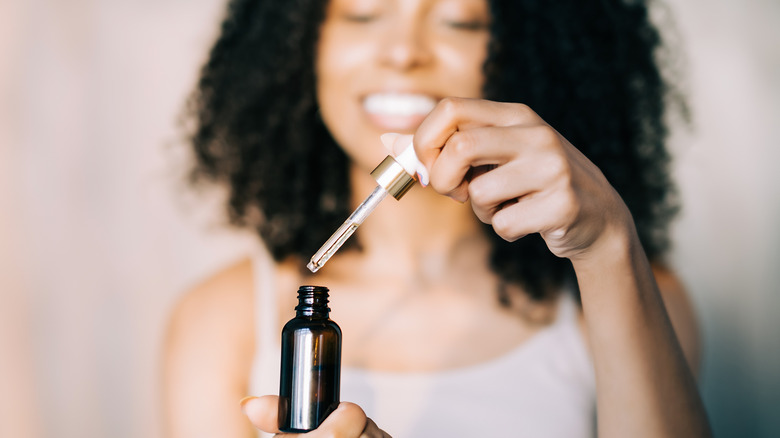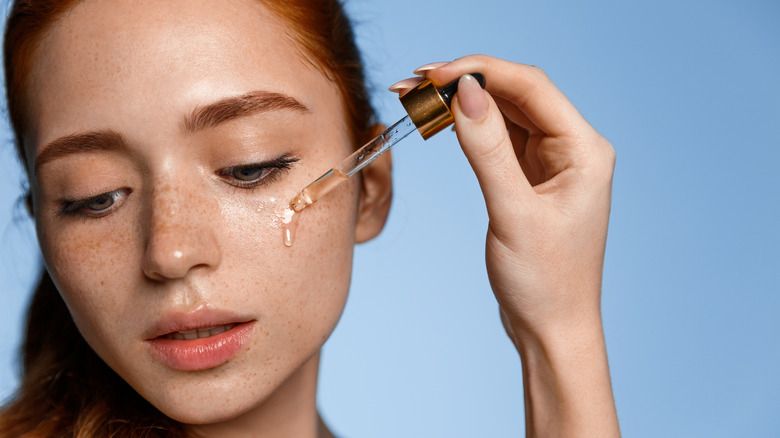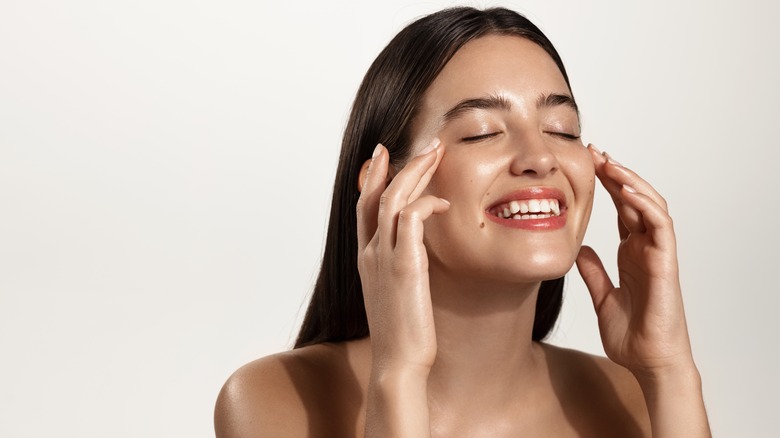Here's How To Make Sure You're Picking The Right Hyaluronic Acid Serum
Despite its daunting name, hyaluronic acid can be a skincare game-changer. When used correctly, this natural humectant can hydrate and plump the skin, reducing the appearance of fine lines and aging. Hyaluronic acid is naturally found in the human body, but when used in beauty products, is produced through biofermentation in a lab (via Harvard Medical School). While experts have noted that hyaluronic acid is the most effective at replacing volume loss when used in injectable dermal fillers, topical hyaluronic acid products make great moisturizers. By applying products containing hyaluronic acid, you can hydrate the surface of the skin without causing irritation.
In particular, hyaluronic acid is ideal for those who have dehydrated skin or want skin that feels more plump and elastic (via Grove). It is also beneficial for those living in arid climates that may dry out their skin. You can find hyaluronic acid in a plethora of beauty products, from moisturizers to night creams to serums, with the latter being particularly popular. But not all hyaluronic acid serums are created equal. Picking the right one comes down to knowing your skin type and knowing what ingredients to look out for.
Which hyaluronic acid serum is best?
Different skin types require different products, and that logic definitely applies to hyaluronic acid serums. According to skincare brand Derm Collective, serums typically come in two varieties: oil-based and water-based. Oil-based serums tend to be more suitable for people with normal or dry skin types, as they take longer to absorb into the skin and have an enhanced hydrating effect. By contrast, water-based serums are less likely to clog pores and are absorbed into the skin more quickly, making them better for those with oily skin or prone to acne. Regardless of the type of serum you choose, there are certain signs that a hyaluronic acid product is of good quality. Look out for serums that are free of mineral oils, fragrances, parabens, silicone, antibacterial agents, and colorings.
Another sign of high-quality hyaluronic acid serum is a well-balanced concentration, with the percentage of hyaluronic acid in the serum sitting at just over 2% (via Ghost Democracy). Those with lower concentrations tend not to be as hydrating, while those with concentrations that are too high can absorb water away from your skin and actually dry it out. Hawai'i's Koru Medical Spa advises choosing a serum that lists fractionated hyaluronate in the ingredients, as this will penetrate past the surface level of the skin. Ideally, it should also be listed in the first three ingredients; otherwise, the percentage of fractionated hyaluronate in the product may be minimal.
How to use hyaluronic acid
Hyaluronic serums are best applied using the palms of your hands. Apply a few drops after cleansing your face when your skin is still damp, and then lock in the hydration with a moisturizer (via Healthline). Follow the directions on the packaging for specific instructions, but hyaluronic acid serum is generally safe for use every day, morning, and night. One of the biggest mistakes that people make with hyaluronic acid serum is applying it to dry skin. Since it works by pulling moisture like a sponge, it will absorb moisture from deep in your skin if there's no other source of moisture for it to pull (via Sofia Latif).
Hyaluronic acid can also be used in conjunction with other products and ingredients to enhance its hydrating effects. Skincare brand Kiehl's explains that vitamin C is one such ingredient that pairs well with hyaluronic acid. On its own, vitamin C is an antioxidant that can promote elasticity and collagen production, improving the appearance of lines and wrinkles. You can use products that contain both hyaluronic acid and vitamin C to reap the benefits of both, or you can use each ingredient separately. As a rule of thumb, apply thinner products first and seal them in with thicker products afterward. Incorporating hyaluronic acid into your beauty routine is simple, and as long as you're using a high-quality product that suits your skin type, you should start to see a boost in hydration and smoothness.


